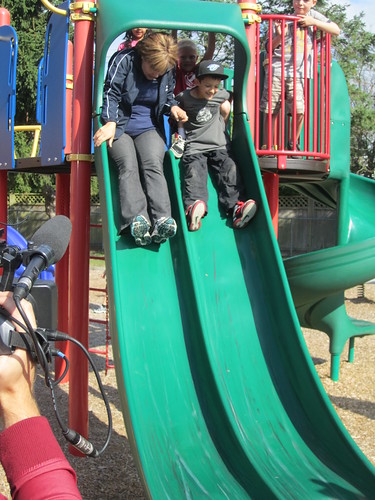Thursday, March 22, 2012
What is Nutrition in Education: School Food Environment
What is Nutrition in Education: School Food Environment
The school environment is a difficult concept to define, as it is a concept that seems fairly easily explained, but the more you examine the idea of school environment, the more expansive the concept becomes. The school environment encompasses the physical environment, the policies and procedures that shape the proceedings of the school and the attitudes attached to these proceedings. Not all aspects of the school environment are tangible, but a great many of them have an impact on healthy eating and physical activity of the students in which they preside.
 |
| Visually appealing healthy foods promote healthy food choices by USDAgov |
The CDC defines a healthy school environment as the physical and aesthetic surroundings and the psychological climate and culture of the school. Wechsler et al. further explain that environmental factors may be social, institutional or physical. Examples of social environment include role modeling and social norms (which can be defined by our peers, family or the media). Institutional factors include rules and polices, while physical factors include appearance and physical structures.
One of the most obvious aspects of the school environment, and one that we have discussed previous in this blog, is the availability of vending machines. At first glance, a vending machine is quite apparent as a physical structure. However, it is also an element of the school environment that is actively decided upon, meaning a policies exists as to when, if and how students can access the machine. How peers use the machine also has an affect on student uses. Suddenly a vending machine, which naturally has a direct impact on the dietary habits of students has numerous complexities in relationship to its involvement in the school environment.
 |
| Children play more vigorously during recess when teachers engage them in play by BC Gov Photos |
Environmental interventions are designed to (1) provide access to opportunities for engaging in health-enhancing behavior, while eliminating or weakening those aspects of the environment that make it easier for individuals to engage in health-compromising behavior, and (2) highlight positive role models, generate social support, and establish rewards and cues to action for engaging in health-enhancing behaviors.
- Wechsler et al.
I believe at this point there is no doubt in your mind that I could not possibly cover all the innumerable interventions to the school environment that could be made in order to improve health and physical activity behaviors of our school-bound youth, however, here are a couple of examples.
- Verstraete et al. found moderate physical activity can be increased in elementary children from 38 to 50% simply by providing children with play equipment such as balls, flying discs, skipping ropes, juggling equipment, and badminton ratchets and having teachers encourage use of equipment.
- Reicks et al have found that exposing children to photography of vegetables increases lunch line selection.
- Wechsler et. al examined the school food environment and found a number of environmental interventions that can improve physical activity and healthy eating behaviors
- There was a significant decrease in plate waste (children ate more of their lunch) when recess was scheduled before lunch.
- Access to school property such as gyms, basket ball and tennis courts outside of school hours increase physical activity and decreased juvenile crime. (This is a good reason to support Senate Bill 110!)
- 88% of high schools , 61% of middle schools, and 14%of elementary schools had food or beverage vending machines that students were allowed to use.
By reducing the price of nutrient dense foods in vending machines by 50%, sales of these food items increased from 26-46% of all sales.
Sources:
Centers for Disease Control and Prevention. Guidelines for school and community programs to promote lifelong physical activity among young people. MMWR 1997;46 (No. RR-6)
Verstraete, S J, Cardon, G M, De Clercq, D L , De Bourdeaudhuij, I M M, (2006). Increasing children’s physical activity levels during recess periods in elementary schools: The effects of providing game equipment. European Journal of Public Health, 16:4, 415–9.
Wechsler H., Devereaux, R. S., Davis, M., Collins, J. (2000). Using the school environment to promote physical activity and healthy eating. Preventive Mdicine, 31, S121-37.
Reicks, M, Redden, J P, Mann, T, Mykerezi, E, Vickers, Z, (2012). Photographs in lunch tray compartments and vegetable consumption among children in elementary school cafeterias. JAMA. 2012;307(8):784-785.
Labels: What is Nutrition Education
0 Comments:
Post a Comment
<< Home